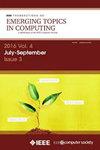TampML:基于 NoC 的 MPSoC 中的篡改攻击检测和恶意节点定位
IF 5.4
2区 计算机科学
Q1 COMPUTER SCIENCE, INFORMATION SYSTEMS
IEEE Transactions on Emerging Topics in Computing
Pub Date : 2024-08-26
DOI:10.1109/TETC.2024.3434663
引用次数: 0
摘要
对计算资源需求的持续增长刺激了具有多种创新架构的大规模高性能芯片的发展。片上网络(NoC)模式已经成为多处理器片上系统(MPSoC)设计中片上通信的主要系统。然而,日益增加的复杂性和对外包第三方知识产权(3pip)的依赖引入了不可忽视的风险,即不受信任的IP供应商插入硬件木马(HT)。高温传输造成的最严重的威胁之一是对通信数据包的篡改。在本文中,我们介绍了一个用于检测篡改攻击和在noc中定位ht的综合框架。该框架被整合到利用NoC结构的新型分布式监控体系结构中。利用机器学习模型进行恶意飞行检测和高精度HT节点定位算法,该框架的有效性已通过真实PARSEC基准工作负载的测试得到证实。该框架的检测准确度和精度分别达到99.8%和99.5%,在大多数情况下,该框架可以以高达100%的精度和召回率定位HT节点。此外,本地化的数据成本平均仅为篡改飞行的3.7%,显著提高了效率,比我们最初的方法快了11倍。作为对抗通信数据篡改攻击的全面和先进的安全解决方案,它在保持最小功耗和硬件开销的同时实现了预期的性能。本文章由计算机程序翻译,如有差异,请以英文原文为准。
TampML: Tampering Attack Detection and Malicious Nodes Localization in NoC-Based MPSoC
The relentless growth in demand for computing resources has spurred the development of large-scale, high-performance chips with diverse, innovative architectures. The Network-on-Chip (NoC) paradigm has become a predominant system for on-chip communication within Multi-Processor System-on-Chip (MPSoC) designs. However, the increasing complexity and the reliance on outsourced Third-Party Intellectual Properties (3PIPs) introduce non-negligible risks of Hardware Trojan (HT) insertions by untrusted IP vendors. One of the most critical threats posed by HTs is the tampering with communication data packets. In this article, we introduce a comprehensive framework for the detection of tampering attacks and localization of HTs within NoCs. This framework is incorporated into a novel distributed monitoring architecture that leverages the NoC structure. Utilizing a machine learning model for malicious flit detection and a high-precision algorithm for HT node localization, the framework's efficacy has been substantiated through tests with real PARSEC benchmark workloads. Achieving an impressive detection accuracy and precision of 99.8% and 99.5% respectively, the framework can localize HT nodes with up to 100% precision and recall in most cases. Furthermore, the data cost of localization is on average only 3.7% of tampered flits, which is significantly more efficient—up to 11 times faster—than our initial methods. As a comprehensive and cutting-edge security solution for combating communication data tampering attacks, it accomplishes the expected performance while maintaining minimal power and hardware overhead.
求助全文
通过发布文献求助,成功后即可免费获取论文全文。
去求助
来源期刊

IEEE Transactions on Emerging Topics in Computing
Computer Science-Computer Science (miscellaneous)
CiteScore
12.10
自引率
5.10%
发文量
113
期刊介绍:
IEEE Transactions on Emerging Topics in Computing publishes papers on emerging aspects of computer science, computing technology, and computing applications not currently covered by other IEEE Computer Society Transactions. Some examples of emerging topics in computing include: IT for Green, Synthetic and organic computing structures and systems, Advanced analytics, Social/occupational computing, Location-based/client computer systems, Morphic computer design, Electronic game systems, & Health-care IT.
 求助内容:
求助内容: 应助结果提醒方式:
应助结果提醒方式:


